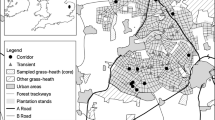Abstract
Whether neutral or deterministic factors structure biotic communities remains an open question in community ecology. We studied the spatial structure of a desert grassland grasshopper community and tested predictions for species sorting based on niche differentiation (deterministic) and dispersal limitation (neutral). We contrasted the change in species relative abundance and community similarity along an elevation gradient (i.e., environmental gradient) against community change across a relatively homogeneous distance gradient. We found a significant decrease in pairwise community similarity along both elevation and distance gradients, indicating that dispersal limitation plays a role in structuring local grasshopper communities. However, the distance decay of similarity was significantly stronger across the elevational gradient, indicating that niche-based processes are important as well. To further investigate mechanisms underlying niche differentiation, we experimentally quantified the dietary preferences of two common species, Psoloessa texana and Psoloessa delicatula, for the grasses Bouteloua eriopoda and Bouteloua gracilis, which are the dominant plants (~75% of total cover) in our study area. Cover of the preferred host plant explained some of the variation in relative abundances of the two focal species, although much variance in local Psoloessa distribution remained unexplained. Our results, the first to examine these hypotheses in arid ecosystems, indicate that the composition of local communities can be influenced by both probabilistic processes and mechanisms based in the natural histories of organisms.




Similar content being viewed by others
References
Adler PB, HilleRisLambers J, Levine JM (2007) A niche for neutrality. Ecol Lett 10:95–104
Allred KW (1997) A field guide to the grasses of New Mexico, 2nd edn. Agricultural Experiment Station, New Mexico State University, Las Cruces
Anderson RV, Tracy CR, Abramsky Z (1979) Habitat selection in two species of short-horned grasshoppers. Oecologia 38:359–374
Báez S, Collins SL, Lightfoot D, Koontz TL (2006) Bottom-up regulation of plant community structure in an aridland ecosystem. Ecology 87:2746–2754
Bray JR, Curtis JT (1957) An ordination of the upland forest communities of southern Wisconsin. Ecol Monogr 27:325–349
Brown JH (1995) Macroecology. The University of Chicago Press, Chicago and London
Caswell H (1976) Community structure: a neutral model analysis. Ecol Monogr 46:327–354
Chase JM, Leibold MA (2003) Ecological niches: linking classical and contemporary approaches. University of Chicago Press, Chicago
Chase JM, Amarasekare P, Cottenie K, Gonzalez A, Holt RD, Holyoak M, Hoopes MF, Leibold MA, Loreau M, Mouquet N, Shurin JB, Tilman D (2005) Competing theories for competitive metacommunities. In: Holyoak M, Leibold MA, Holt MA (eds) Metacommunities: spatial dynamics and ecological communities. University of Chicago Press, Chicago
Chave J (2004) Neutral theory and community ecology. Ecol Lett 7:241–253
Chave J, Leigh EG (2002) A spatially explicit neutral model of beta-diversity in tropical forests. Theor Popul Biol 62:153–168
Chesson P, Huntly N (1997) The roles of harsh and fluctuating conditions in the dynamics of ecological communities. Am Nat 150:519–553
Condit R, Pitman N, Leigh EG, Chave C, Terborgh J, Foster RB, Núñez, Aguilar S, Valencia R, Villa G, Muller-Landau HC, Losos E, Hubbell SP (2002) Beta-diversity in tropical forest trees. Sciences 295:666–669
Etienne RS, Olff H (2004) A novel genealogical approach to neutral biodiversity theory. Ecol Lett 7:170–175
Gardiner T, Hill J, Chesmore D (2005) Review of the methods frequently used to estimate the abundance of Orthoptera in grassland ecosystems. J Insect Conserv 9:151–173
Gilbert B, Lechowicz MJ (2004) Neutrality, niches, and dispersal in a temperate forest understory. Proc Natl Acad Sci USA 101:7651–7656
Google (2007) Google Earth 4.1.7076.4458 (beta). earth.google.com
Gottschalk E, Griebeler EM, Waltert M, Muhlenberg M (2003) Populations dynamic in the Grey Bush Cricket Platycleis albopuncatata (Orthoptera: Tettigoniidae)—what causes interpopulation differences? J Insect Conserv 7:45–58
Heidorn TJ, Joern A (1984) Differential herbivory on C3 versus C4 grasses by the grasshopper Ageneotettix deorum (Orthoptera: Acrididae). Oecologia 65:19–25
Heidorn TJ, Joern A (1987) Feeding preference and spatial distribution of grasshoppers (Acrididae) in response to nitrogen fertilization of Calamovilfa longifolia. Funct Ecol 1:369–375
Hiltunen T, Laakso J, Kaitala V (2006) Interactions between environmental variability and immigration rate control patterns of species diversity. Ecol Modell 194:125-131
Hubbell SP (1997) A unified theory of biogeography and relative species abundance and its application to tropical rain forests and coral reefs. Coral Reefs 16(Suppl 1):S9–S21
Hubbell SP (2001) The unified neutral theory of biodiversity and biogeography. Princeton University Press, Princeton and Oxford
Hubbell SP (2006) Neutral theory and the evolution of ecological equivalence. Ecology 87:1387–1398
Hutchinson GE (1957) Homage to Santa Rosalia or why are there so many kinds of animals? Am Nat 93:145–159
Isely FB (1938) The relationships of Texas Acrididae to plants and soils. Ecol Monogr 8:551–604
Isern-Vallverdu J, Pedrocchi-Renault C, Voisin JF (1993) A comparison of methods for estimating density of grasshoppers (Insecta: Orthoptera) on alpine pastureland. Rev Alp Ecol II:73–80
Ivey RD (2003) Flowering plants of New Mexico, 4th edn. Ivey, Albuquerque
Joern A (1979) Feeding patterns in grasshoppers (Orthoptera: Acrididae): factors influencing diet specialization. Oecologia 38:325–347
Jones MM, Tuomisto H, Clark DB, Olivas P (2006) Effects of mesoscale environmental heterogeneity and dispersal limitation on floristic variation in rain forest ferns. J Ecol 94:181–195
Karst J, Gilbert B, Lechowicz MJ (2005) Fern community assembly: the roles of chance, and the environment at local and intermediate scales. Ecology 86:2473–2486
Kröel-Dulay G, Ódor P, Peters DPC, Hochstrasser T (2004) Distribution of plant species at a biome transition zone in New Mexico. J Veg Sci 15:531–538
Larson DP, O’Neill KM, Kemp WP (1999) Evaluation of accuracy of sweep sampling in determining grasshopper (Orthoptera: Acrididae) community composition. J Agric Urban Entomol 16:207–214
Lekberg Y, Koide RT, Rohr JR, Aldrich-Wolfe L, Morton JB (2007) Role of niche restrictions and dispersal in the composition of arbuscular mycorrhisal fungal communities. J Ecol 95:95–105
MacArthur RH (1957) On the relative abundance of bird species. PNAS 43:293–295
MacArthur RH, Wilson EO (1963) An equilibrium theory of insular zoogeography. Evolution 17:373–387
MacArthur RH, Wilson EO (1967) The theory of island biogeography. Princeton University Press, Princeton
Maurer BA (1999) Untangling ecological complexity: the macroscopic perspective. University of Chicago Press, Chicago
McGill BJ (2003) A test of the unified neutral theory of biodiversity. Nature 422:881–885
McGill BJ, Maurer BA, Wiser MD (2006) Empirical evaluation of neutral theory. Ecology 87:1411–1423
Moore D (2006) Met Central (2006). http://sev.lternet.edu/modules.php?op=modload&name=News&file=index&catid=4
Muldavin EH, Moore DI, Collins SL, Wetherill KR, Lightfoot DC (2008) Above ground net primary production dynamics in a northern Chihuahuan Desert ecosystem. Oecologia 155:123–132
Novotny V, Basset Y, Miller SE, Welbien GD, Brenner B, Cizek L, Drozd P (2002) Low host specificity of herbivorous insects in a tropical forest. Nature 416:841–844
Otte D (1976) Species richness patterns of New World desert grasshoppers in relation to plant diversity. J Biogeogr 3:197–209
Otte D (1981) The North American grasshoppers volume I; Acrididae: Gomphocerinae and Acridinae. Harvard University Press, Cambridge, MA
Otte D (1984) The North American grasshoppers volume II; Acrididae: Oedipodinae. Harvard University Press, Cambridge, MA
Pandolfi JM (2002) Coral community dynamics at multiple scales. Coral Reefs 21:13–23
Pennington DD, Collins SL (2007) Response of an aridland ecosystem to interannual climate variability and prolonged drought. Landsc Ecol 22:897–910
Recher HF, Davis WE, Calver MC (2002) Comparative foraging ecology of five species of ground-pouncing birds in western Australian woodlands with comments on species decline. Ornithol Sci 1:29–40
Ricklefs RE (2006) The unified neutral theory of biodiversity: do the numbers add up? Ecology 87:142–1231
Söderström B, Svensson B, Vessby K, Glimskär A (2001) Plants, insects and birds in semi-natural pastures in relation to local habitat and landscape factors. Biodivers Conserv 10:1839–1863
Thompson R, Townsend C (2006) A truce with neutral theory: local deterministic factors, species traits and dispersal limitation together determine patterns of diversity in stream invertebrates. J Animal Ecol 75:476–484
Tilman D (1982) Resource competition and community structure. Princeton University Press, Princeton
Torrusio S, Cigliano MM, de Wysiecki ML (2002) Grasshopper (Orthoptera: Acrididae) and plant community relationships in Argentine pampas. J Biogeogr 29:221–229
USDA, and NRCS (2004) PLANTS profile: Juniperus monosperma. In USDA, and NRCS (2004) The PLANTS database, version 3.5. National Plant Data Center, Baton Rouge. www.plants.usda.gov
Volkov I, Banavar JR, Maritan A, Hubbell SP (2003) Neutral theory and relative species abundance in ecology. Nature 424:1035–1037
Acknowledgments
We would like to thank R. Dirzo, E. A. Hadly, and E. Mendoza for their comments on a draft of this paper. A. Joern encouraged us to carry out a feeding trial. D. Otte helped in securing geographic data for Psoloessa. We would also like to thank M. T. Friggens and W. Anderegg for their help with GIS. J. E. Johnson helped with fieldwork coordination. A. Fricker, A. Benhumea, S. Whiteman and J. Fencl helped with data collection. This project was made possible by a grant from NSF to S. L. Collins.
Author information
Authors and Affiliations
Corresponding author
Additional information
Communicated by Roland Brandl.
Rights and permissions
About this article
Cite this article
Rominger, A.J., Miller, T.E.X. & Collins, S.L. Relative contributions of neutral and niche-based processes to the structure of a desert grassland grasshopper community. Oecologia 161, 791–800 (2009). https://doi.org/10.1007/s00442-009-1420-z
Received:
Accepted:
Published:
Issue Date:
DOI: https://doi.org/10.1007/s00442-009-1420-z




